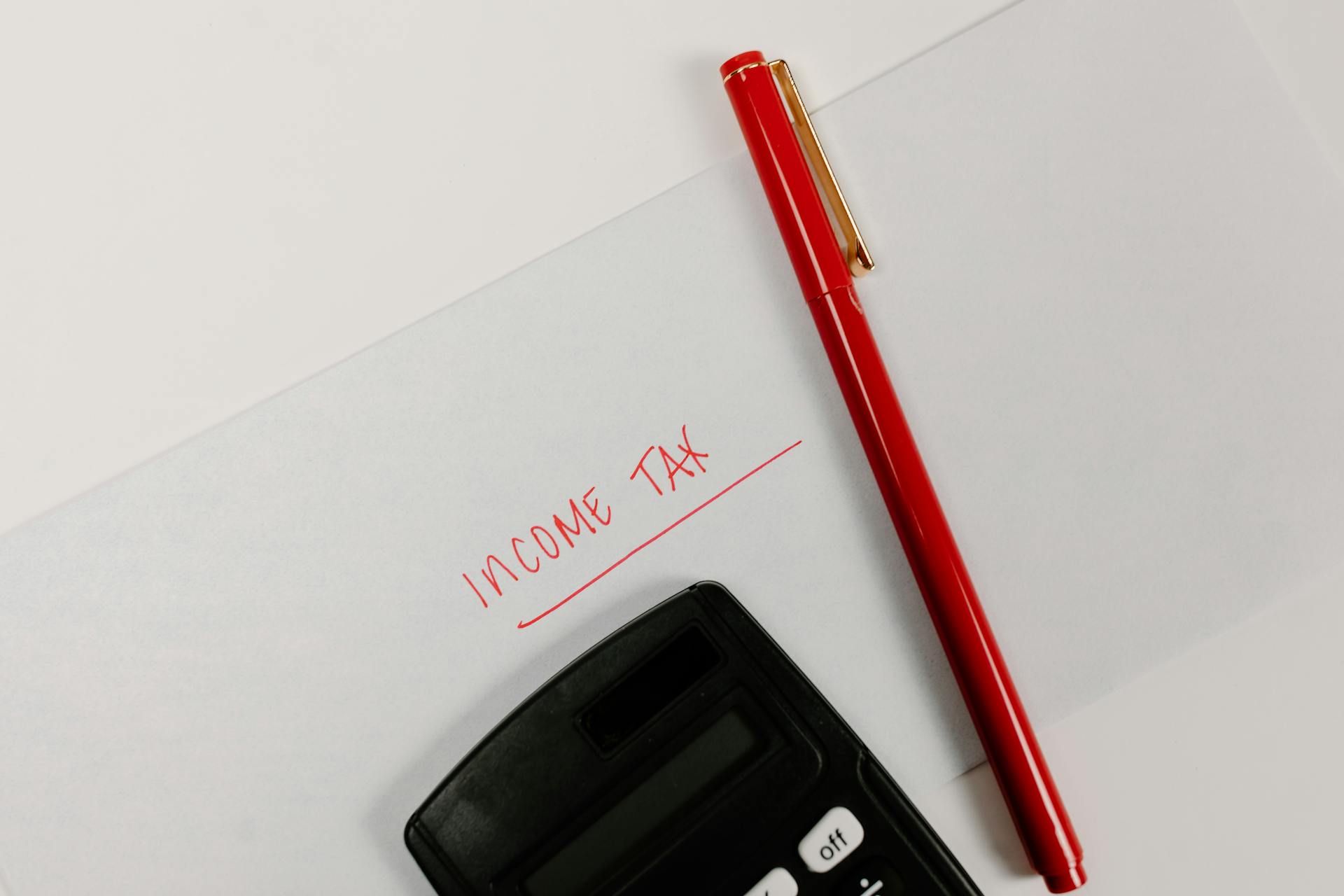
Calculating Earnings Per Common Share (EPS) is a crucial step for business owners to understand their company's financial performance. EPS is a key metric used to evaluate a company's profitability and growth potential.
To calculate EPS, you need to know the company's net income and the total number of common shares outstanding. This information can be found in the company's income statement and balance sheet.
Business owners can use the EPS formula to calculate their company's EPS: EPS = Net Income / Total Number of Common Shares Outstanding. This formula helps to determine the profit per share of the company's common stock.
Understanding EPS is essential for business owners to make informed decisions about their company's future, such as issuing dividends or raising capital.
Worth a look: Nopat vs Net Income
What Is
Earnings per share (EPS) is a measure of a company's profitability that indicates how much profit each outstanding share of common stock has earned. It's calculated by dividing the company's net income by the total number of outstanding shares.
Consider reading: How Do You Find the Number of Shares Outstanding
A high EPS usually means the company is doing well and might attract more investors. This is because a high EPS indicates that the company is generating a lot of profit from each share.
The profit figure used to calculate EPS is usually the company's net profit, which is the profit after all expenses, including operating expenses, interest paid on borrowings, and taxes. This is also known as GAAP net profit, as its calculation confirms to Generally Accepted Accounting Principles.
EPS can be reported as either "adjusted" or "unadjusted". Adjusted EPS may exclude one-time factors such as fees related to a merger, or other unusual costs, while unadjusted EPS uses the company's actual net profit.
Here are some key factors that affect EPS:
- Revenue earned by the company
- Costs occurred in the process
- Dividends on preferred stock
- Average outstanding common shares
Note that the average common share is different from the average calculated by an average calculator, and its value can fluctuate based on changes in the number of shares outstanding.
Importance in Financial Analysis
Earnings Per Share (EPS) is a crucial metric in financial analysis. It's used to value a company by comparing EPS with the share price, giving investors an idea of the earnings value and growth potential.
By analyzing EPS trends over time, you can see a company's financial health and growth chances. This is because EPS shows how well a company is performing in terms of generating profits for its shareholders.
Publicly traded companies must report their EPS on the income statement, which is a key document in financial analysis. You'll find EPS near the bottom of the income statement, often displaying current and previous year data for comparison.
The price-to-earnings (P/E) ratio is a key way to value a company using EPS. It compares EPS to the share price, showing how much investors pay for each dollar of earnings. A higher P/E ratio may indicate that a company is overvalued, while a lower ratio may suggest it's undervalued.
Intriguing read: Lgen Share Price
Here's a simple way to look at the relationship between EPS and other financial metrics:
By looking at these metrics together, you can get a full picture of a company's financial health and value. This approach helps in making smart investment choices and shows a company's true market worth.
A unique perspective: What Are B Shares
Calculating EPS
Calculating EPS is a straightforward process that requires just a few simple steps. To start, you'll need to find the net income from the income statement.
The next step is to subtract preferred dividends from the net income. This is because EPS shows the earnings for common shareholders only.
The formula is (net income - preferred dividends) / weighted average shares outstanding. This might sound complicated, but it's actually quite simple.
For example, let's say a company has a net income of $1,000,000 and preferred dividends of $250,000. They also have 11,000,000 weighted average shares outstanding. Plugging these numbers into the formula gives us ($1,000,000 - $250,000) / 11,000,000 = $0.068 per share.
A fresh viewpoint: Business Margin Formula
You can also use a quality earning per share calculator to get accurate results without investing precious time. This is especially helpful for stock traders and investors who don't have a lot of time to spare.
To calculate EPS using Excel, you'll need to input the net income, preferred dividends, and number of common shares outstanding into three adjacent cells. Then, use the formula "=B3-B4" to subtract preferred dividends from net income, and "=B6/B5" to render the EPS ratio.
The basic EPS formula has three main parts: net income, preferred dividends, and weighted average shares outstanding. These components are crucial in understanding the financial standing of a company.
Here's a simple formula to calculate basic EPS: (net income - preferred dividends) / weighted average shares outstanding. This formula is the same as the one used in the example with Company X, which made $750,000 in net income and paid $80,000 in preferred dividends during the previous year.
The weighted average shares outstanding method takes into account changes in the number of shares during the year. This is important for getting the right EPS when the number of shares changes.
Here's a summary of the basic EPS formula:
- Net income: The company's earnings after all expenses and taxes
- Preferred dividends: Money paid to preferred shareholders
- Weighted average shares outstanding: The average number of common shares over a period
EPS Calculation Process
Calculating EPS involves several steps. You need to find the net income from the income statement.
To calculate basic EPS, follow these steps: find the net income, subtract preferred dividends, determine the weighted average shares outstanding, and divide the result by the weighted average shares outstanding.
The formula for calculating EPS is straightforward: (net income – preferred dividends) / weighted average shares outstanding. For example, using the values from a company's income statement, you would calculate EPS as ($1,000,000 – $250,000) / 11,000,000 = $0.068 per share.
You can also calculate EPS using a quality earning per share calculator or a spreadsheet like Excel.
If this caught your attention, see: Outstanding Common Stock Refers to the Total Number of Shares
Step-by-Step Calculation Process
Calculating EPS involves a straightforward process that can be broken down into four simple steps.
First, find the net income from the income statement. This is the starting point for your EPS calculation.
Next, subtract preferred dividends from the net income. Preferred dividends are a type of dividend that must be paid to shareholders before common stockholders receive any dividends.
Curious to learn more? Check out: What Are Preferred Shares
Now, determine the weighted average shares outstanding. This is the number of shares that are outstanding and eligible to receive dividends.
Finally, divide the result from step 2 by the result from step 3. This will give you the basic EPS.
Here's a quick example to illustrate the process:
Using the formula: ($1,000,000 – $250,000) / 11,000,000 = $0.068 per share.
To make the calculation process even easier, you can use a quality earning per share calculator, which can generate accurate results without the need for manual calculations.
Treasury Stock Method
The Treasury Stock Method is a useful tool for figuring out the effect of options and warrants on earnings per share.
It assumes that any money made from these securities is used to buy back shares at current prices, as stated in the Treasury Stock Method.
This method helps to accurately calculate EPS, especially when dealing with complex securities like options and warrants.
The Treasury Stock Method is a straightforward approach that considers the impact of buying back shares on the company's capital structure.
It's a practical tool that helps investors and analysts get a clearer picture of a company's financial performance.
Excluding Extraordinary Items
Excluding Extraordinary Items helps investors see a company's true performance. Analysts often leave out special items from EPS to get a clearer picture.
Companies might have one-time events that change their earnings a lot, like selling a factory on valuable land. This transaction creates a windfall profit, but it's considered an "extraordinary item" because it's unlikely to happen again.
A similar situation occurs if a company has an unusual loss, like a factory burning down. This temporary decrease in EPS should also be excluded for the same reason.
Including these events in the EPS calculation might mislead shareholders into thinking the company's performance is better than it actually is.
Example and Calculation
Calculating earnings per share (EPS) is a straightforward process that can be broken down into a few simple steps. To calculate basic EPS, you need to find the net income from the income statement, subtract preferred dividends, determine the weighted average shares outstanding, and then divide the result by the weighted average shares outstanding.
Suggestion: Is Net Income Equity
The formula for basic EPS is ($1,000,000 – $250,000) / 11,000,000 = $0.068 per share, as seen in Example 2.
Basic EPS is calculated by dividing earnings by basic share count, which is a simple calculation. However, diluted EPS is a bit trickier, as it involves considering the impact of outstanding options or shares.
For example, in Example 3, ABC Corporation has 1 million stock options outstanding with an exercise price of $10, while its stock trades at $20. The exercise of those options would add 1 million shares to the basic count, but the company could also acquire 500,000 shares with the $10 million in proceeds.
Here's a summary of the steps to calculate diluted EPS:
- Determine the basic share count
- Calculate the potential dilutive impact of outstanding options or shares
- Add the potential dilutive shares to the basic share count
- Divide the earnings by the diluted share count
For instance, in Example 3, ABC Corporation's diluted share count equals 10 million shares plus another 500,000 (the 1 million shares underlying options, less than 500,000 theoretically repurchased). Diluted EPS is calculated by dividing the $10 million in net profit by the 10.5 million in diluted shares, giving a result of 95 cents.
Consider reading: Diluted Shares Outstanding Meaning
Using a calculator or spreadsheet can make the EPS calculation process much faster and more accurate. As mentioned in Example 4, a quality earning per share calculator can generate accurate results without the investment of precious time.
Here's a simplified example of how to calculate EPS using Excel, as seen in Example 6:
- Input the net income into Excel, preferred dividends, and number of common shares outstanding into three adjacent cells
- In cell B6, input the formula "=B3-B4" to subtract preferred dividends from net income
- In cell B7, input the formula "=B6/B5" to render the EPS ratio
For example, if the net income is $15,000, preferred dividends are $7,000, and the average outstanding common shares are 4,000, the EPS calculation would be:
EPS = (15000 – 7000)/4000 = $2.25 per share
Advanced Considerations
Calculating earnings per common share (EPS) can be a straightforward process, but there are some advanced considerations that can make your investment checks more detailed and accurate. EPS calculations can be made more detailed to show a company's true financial health.
To get a more comprehensive picture, you can consider the company's operating cash flow, which can be a more reliable indicator of financial health than net income. Advanced EPS calculations can also take into account the company's debt and equity, giving you a better understanding of its capital structure.
The company's dividend payments can also be factored into the EPS calculation, providing insight into its ability to generate cash for shareholders. This is especially important for investors who rely on dividend income.
Key Considerations
Calculating earnings per common share (EPS) is a crucial step in understanding a company's financial health. It's essential to consider the following key factors to get a complete picture.
EPS doesn't take the current stock price into account, so a high EPS doesn't always mean a company is a good investment. The stock price can be overvalued, making it a poor investment despite the company's good performance.
EPS calculations also overlook extraordinary income events or expenses, which can temporarily boost or harm a company's finances. For example, a one-time sale can lead to a high EPS, but it may not be sustainable.
To get a more accurate picture, you need to look beyond EPS trends and understand the underlying reasons for changes in EPS. A company's EPS might go down due to increased research and development spending, which could be a good long-term move.
Here are some key considerations to keep in mind:
- EPS might not account for one-time events or seasonal changes.
- A high EPS can be due to a variety of factors, including sales, share buybacks, and decreasing costs.
- EPS should be compared against competitor metrics or across a period of time for a more accurate picture.
Frequently Asked Questions
How is earnings per common share calculated in Quizlet?
Earnings per common share is calculated by dividing net profit by the average number of common stock shares outstanding. This simple formula helps investors understand a company's profitability per share.
Sources
Featured Images: pexels.com


